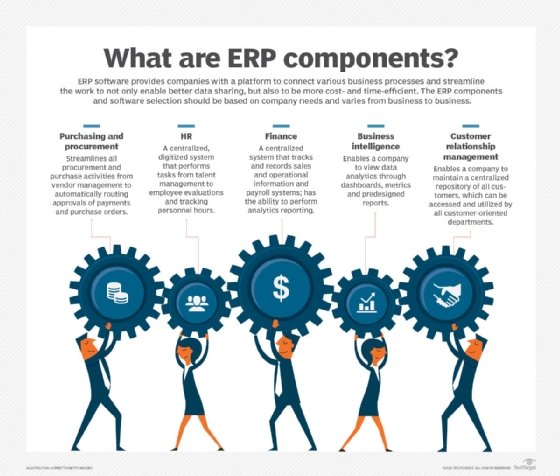
skvoor - Fotolia
Discover the core ERP system components
Discover core ERP systems components, as well as the benefits and challenges of implementing ERP in your organization.
An ERP system is a suite integrated applications that a company uses to connect its business activities across departments so that everyone is working with the same data and processes.
Companies can use ERP systems to streamline and improve the efficiency their operations, which saves time and money. In the course implementing ERP, companies can also standardize and automate many business processes to eliminate manual effort and save time.
Before a company starts implementing ERP systems, there are various ERP system components that a company must select, often depending on the specific business processes it wants to improve and whether it is selling products or services.
Businesses that sell products are likely to have manufacturing, supply chain, inventory management and distribution functions that the ERP system must address. For organizations that sell services, ERP capabilities, such as project management for service engagements and support for field services and sales operations, are crucial.
Benefits of an ERP system
Because the ERP system offers a single repository for companywide data, the risks associated with working with disparate systems and data -- such as the potential for error or duplication of business functions in different departments -- can be reduced.
Large enterprises in particular have many different systems, often independently installed by departments. They may want to implement a single ERP system that takes the place of these earlier systems to eliminate the operational inefficiencies and time delays that have developed through the years.
SMBs can take advantage of these benefits, too. In addition, an ERP system can help them level the playing field with their larger enterprise competitors. These companies may want to select an ERP system that they can expand to accommodate growth.
With cloud-based ERP offerings, even many small companies that lack the internal resources or expertise to institute ERP software can take advantage of the lower cost and technical expertise of vendors and, in turn, quickly gain business efficiencies.
Finally, many look for ERP software that is specialized to the needs and requirements of their particular industries. Several ERP vendors provide this industry vertical specialization.
When choosing an ERP system, companies can opt for ERP software either as a comprehensive suite or as a smaller suite encompassing only financial applications, financial and manufacturing applications, or only service applications. Companies can also purchase a specifically designed ERP system of a particular industry vertical, like construction or the food and beverage industry.
Cloud vs. on-premises vs. hybrid ERP
The modern ERP market can be confusing, especially when it comes to cloud ERP, so in-depth research is a must before creating implementation plans. In the broadest strokes, ERP software vendors typically offer ERP in on-premises, cloud or hybrid versions, although some smaller vendors offer cloud only.
With on-premises ERP, an organization's IT department manages the hardware and software. IT runs the software in the organization's data center and is responsible for implementation, maintenance and customization. This is typically the most expensive version of ERP. However, on-premises ERP gives customers more control over security and updates.
Cloud ERP is becoming increasingly popular, especially SaaS versions. With cloud, ERP systems are hosted in the cloud, whether in the vendor's cloud or in a cloud platform such as AWS or Microsoft Azure. Additionally, the company can have the vendor run the system and provide ERP consulting on the business side.
Companies can also opt to have an ERP system that the vendor or a partner hosts at the vendor's site, while corporate IT runs and maintains it.
With a hybrid approach to ERP, organizations elect to have some systems run in-house and others run in the cloud.
Today's ERP vendors that moving to the cloud is the future ERP, as it is for other systems. Accordingly, even major vendors that have established their ERP reputations with on-premises products offer migration paths to cloud-based ERP offerings, sometimes with financial incentives. In other cases, some ERP vendors offer cloud-only systems and have never offered on-premises software. Between these two poles are vendors that offer hybrid ERP systems, which include running ERP both on premises and in the cloud.
There is no one ERP deployment that works for every company. One question the company will need to address is whether it wants ERP entirely in-house, entirely in the cloud or in a hybrid deployment, which uses both.
ERP challenges
The challenge for companies implementing this technology is choosing an ERP system that best matches their business needs and user expectations.
While an ERP system must fit well with the company's existing operations and systems, it must also be able to deliver on key performance and profitability goals that the company's existing systems can't deliver.
This is a tall order and is the reason why ERP has a higher failure rate than any other software. It can be a career-ending project for many managers if an ERP installation doesn't go well.
For an ERP decision-maker -- whether an internal ERP user, a CFO, a COO or a vice president of manufacturing -- it is important to find an ERP partner capable of working together on system installation, integration, consultation, training and support throughout the process.
Finding the implementation that works best for the company -- whether on-premises ERP, hybrid ERP or cloud-based ERP -- is equally critical. With cloud ERP, vendor involvement can range from the vendor simply hosting the ERP system at its site while the company runs it, all the way to the company outsourcing the entire ERP system and its support to the vendor.
Core ERP system components
Before choosing an ERP system, companies will want to look at the core set of components and determine what they need, or what they can integrate with their existing software or a third-party component. Components, also referred to as modules, are the parts of the ERP system that focus on functional areas. Here is a look at those typically considered core system components, although vendors may vary in their categorization of that.
Finance
Companies want to record, track and consolidate all of their sales and operational information in a central accounting system. ERP financial software delivers this capability with a centralized general ledger, accounts receivable, accounts payable and payroll systems.
Companies also want the ability to perform analytics reporting and what-if scenario modeling on their financials, which many ERP systems provide.
HR
ERP offers a centralized HR system that enables organizations to track personnel hours and employee performance evaluations throughout the company, as well as administer benefits and manage staff development.
Increasingly, companies want to use their HR systems to recruit new talent in the marketplace, map out succession planning and manage corporate compliance issues concerning employees.
Purchasing and procurement
ERP purchasing software streamlines the procurement process, from purchase order issuance and vendor management to payments and reporting.
ERP purchasing software also has the ability to automatically direct approvals of purchase orders and payments to the appropriate corporate decision-makers.
Business intelligence
Organizations want more data analytics that enables them to assess and act on information about the business. To facilitate this, ERP vendors provide dashboards, predesigned reports and even best-in-class metrics and guidelines that companies can use to assess business sales and operations. Many vendors, particularly those catering to large enterprise customers, have expanded their business intelligence capabilities to include real-time analytics, predictive modeling, machine learning and AI to assist with forecasting.
Companies also have the flexibility to perform data mining on their ERP information and to develop their own custom reporting.
Customer experience management
A customer experience management (CEM) component in an ERP system is a centralized repository of customer information that customer-facing departments across the company can access and use. The repository includes information about company interactions with prospects, customers, clients and partners. It can track all of these interactions across marketing, sales, service and any other customer-facing departments to ensure everyone is using the same information. The CEM component includes sales force reporting, tracking and automation, marketing, service and support. It often extends to full customer experience tracking and management, including personalization and customer data analytics.

ERP components for manufacturing
While the components mentioned below are still core to ERP, they cater more to product-oriented companies. Consider these areas before choosing an ERP system.
Supply chain management
Some ERP systems encompass not only the company's internal operations, but also the operations of supply chain business partners and goods suppliers, including raw materials, inventory and supplies. A supply chain management component gives companies much-needed visibility into both their internal and external supply chain, as well as their manufacturing processes.
Certain ERP system components come in handy for companies that are constantly revising their product configurations and designs. Enterprises can track and manage different versions of their products that are still in use with the help of ERP product lifecycle management modules, which store product information at every stage of revision.
Distribution and warehousing
ERP distribution and warehousing systems employ automation that enables the company's customer-facing sales force to link customer quotes and orders directly into back-office inventory management, fulfillment and accounting systems. It then completes and fills orders in a timely manner.
Key features of some ERP systems for distribution also include comprehensive warehouse management functions. These systems ensure that inventory in warehouses is optimized to meet the company's supply chain requirements. For companies managing multiple warehouse locations, these distribution and warehouse systems provide the ability to see their entire inventory and stock movements across all locations, improving inventory management by enabling companies to reassign inventory between locations as needed.
Inventory management
An inventory management system optimizes inventory stocking and consumption and provides for both manual and automatic inventory forecasting. Companies can set order policies for individual parts and assemblies. The software also issues reports on inventory exception and oversupply conditions, and it can track inventory across multiple locations.
These inventory management systems can operate in a stand-alone fashion. The system can also link into logistics, shipping and billing systems. Many inventory management systems also come with support for bar coding, stockkeeping unit management and integration with other types of warehouse technology, such as sensors and hand-held mobile devices.
Service management ERP components
For service management companies and one-off project companies choosing an ERP system component, additional modules serve their specific needs. These include the following areas.
Service management
Service management ERP offers optimization, tracking and management of professional services. Professional service organizations and companies with billable field service functions often use this software. It can also evaluate customer satisfaction levels and service-level agreements, warranty and contract performance.
Service-oriented ERP can additionally track customer contacts through all the stages of a customer relationship -- from prospecting to closing, providing support and upselling. This gives everyone on the service team uniform and complete visibility into the customer relationship and into the company's history with the customer. It also facilitates productive collaboration across the end-to-end services.
One-off project management
Also available in ERP project management software is comprehensive project management. This includes multilevel work breakdown structures for projects, project resource scheduling and bid and contract management.
Resources consumed in the project provide visibility in one-off project management software, including assets, inventory, materials and labor. It also enables accurate and timely billing of project costs throughout the project's lifecycle. Companies can track project profitability and control margins simultaneously with project performance. Using this system enables managers to fine-tune project performance and ensures that employees meet key performance indicators.
Christine Parizo contributed to this report.







